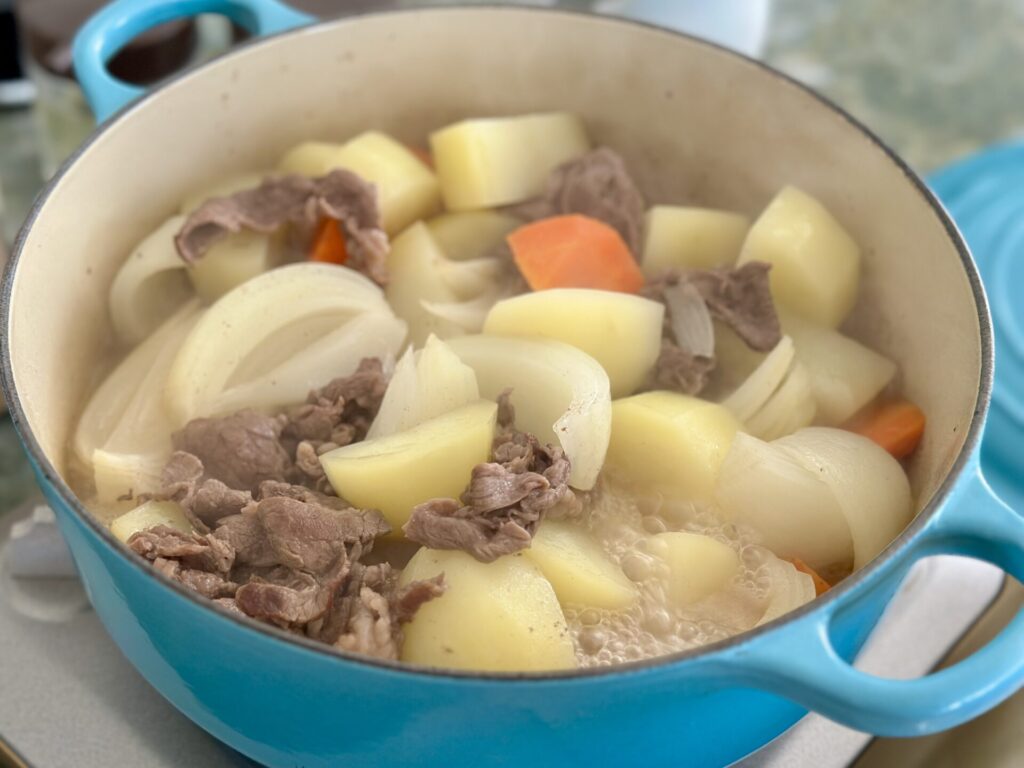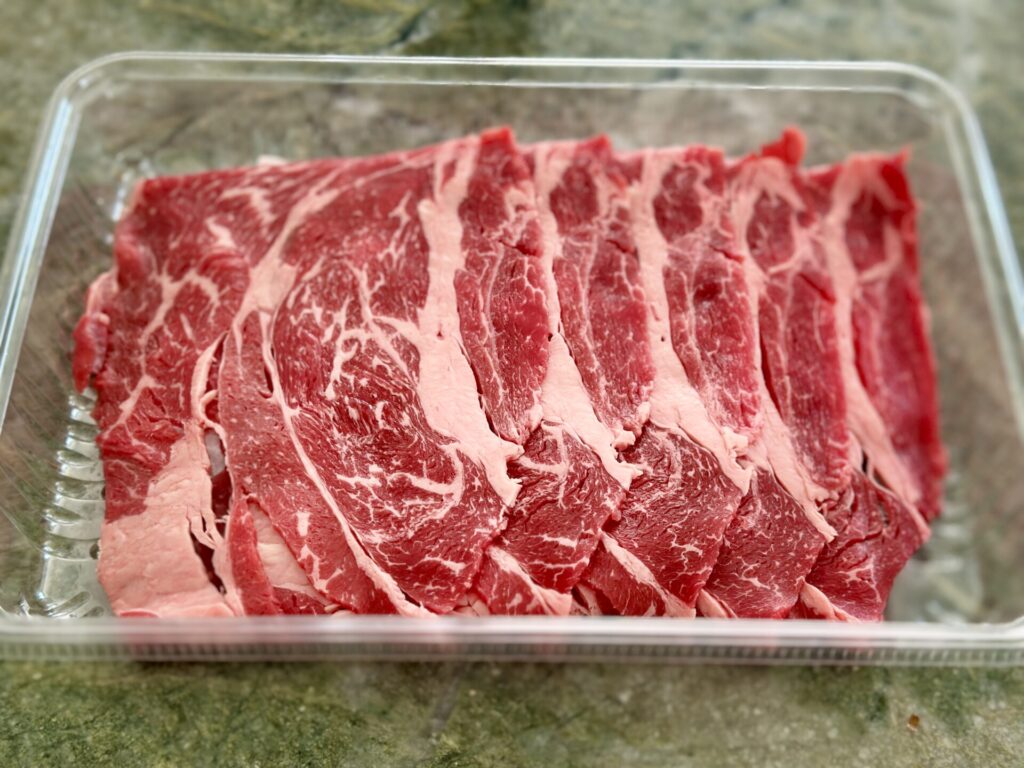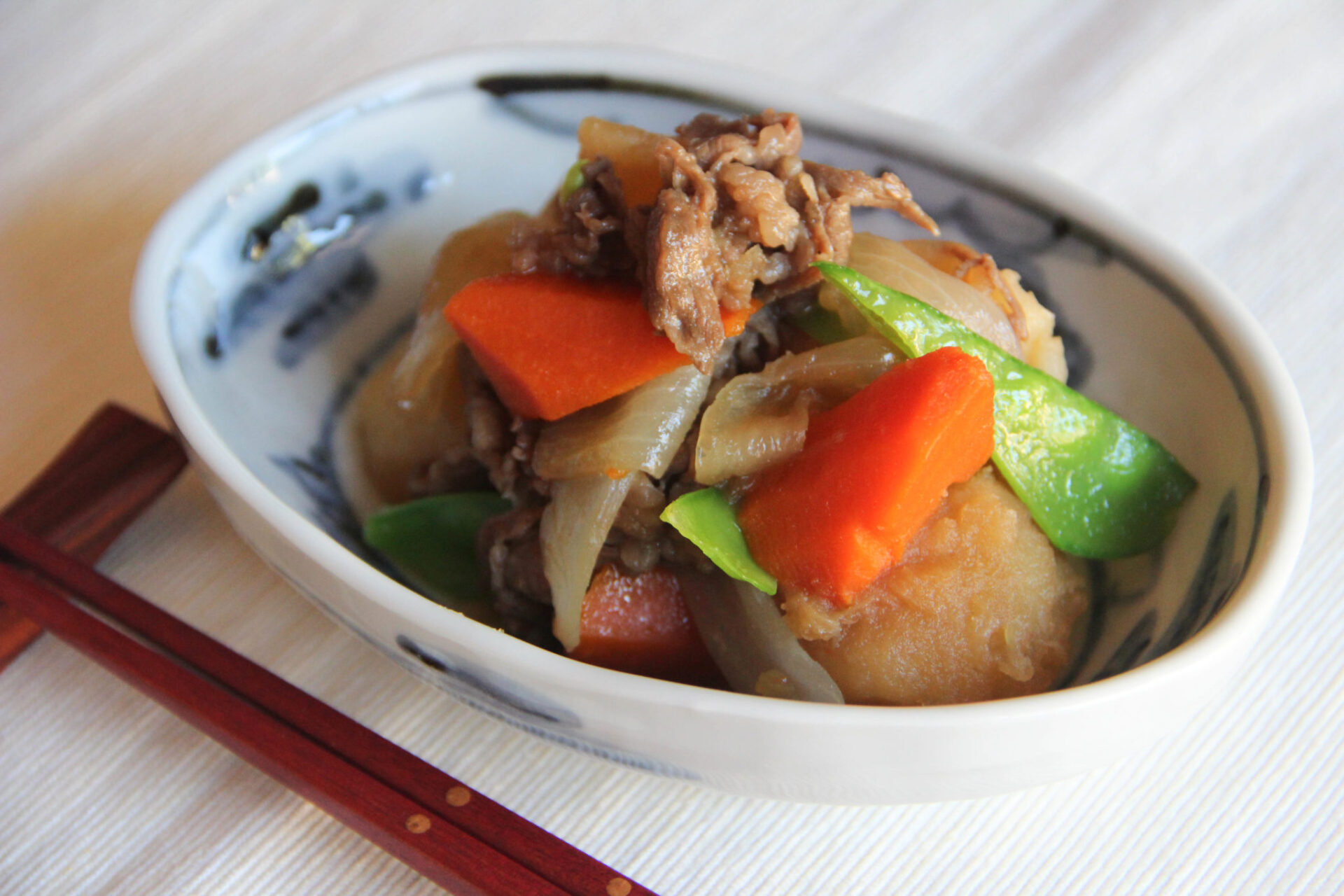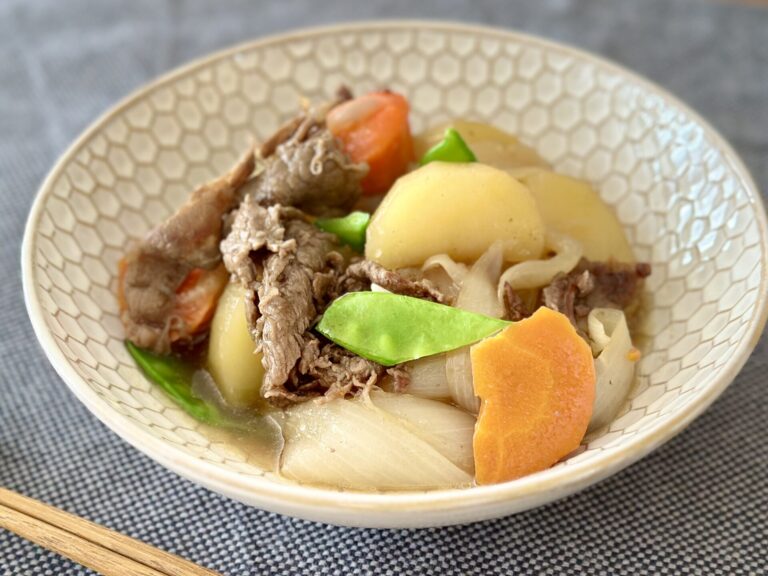Nikujaga (肉じゃが) is a Japanese dish of stewed beef and potatoes in a savory sauce. The name comes from the Japanese words for meat (niku) and potatoes (jagaimo). It is one of the most beloved home-cooked dishes in modern Japanese cuisine.
What’s Nikujaga?
Nikujaga is a stew made primarily with beef and potatoes, often accompanied by other vegetables like onions and carrots, and seasoned with soy sauce and sugar. Despite being a popular staple in Japanese households, its history is surprisingly short. The first known recipe appeared in a housekeeping magazine in the 1950s, and the dish became widely eaten in the 1970s.
Although Nikujaga is mainly a home-cooked dish, it can also be found in old-fashioned diners (Shokudō, 食堂), Izakaya (居酒屋) food bars, and even delis in Japanese supermarkets. Its flavor varies depending on the restaurant or chef, with some versions being sweeter or saltier. The seasoning typically includes soy sauce and sugar, and sometimes sake and mirin as well.

What are the ingredients in Nikujaga?
- Thinly sliced beef is preferred for Nikujaga in western Japan, while thinly sliced pork is more commonly used in eastern Japan.

- If paper-thin beef is hard to find, you can make it yourself. Partially freeze a lump of shoulder loin, then slice it with a knife. Be careful not to freeze it completely, as that would make it impossible to slice by hand.
- For potatoes, if you prefer a soft and fluffy texture, use Russet potatoes. Russet potatoes tend to break down in the broth due to their softness, but this also enhances the dish’s flavor. If you like a smoother, creamier texture, Yukon Gold is a great choice.

- Konnyaku threads (Ito Konnyaku) are often added to Nikujaga for an interesting texture. It’s a type of konnyaku yam cake that is cut into thin, noodle-like strands. But they are optional if you’re not a fan.
- Although Nikujaga is typically a brown-colored dish, you can add a pop of green with snow peas or green beans if you like.
What to serve with Nikujaga?
Even though Nikujaga is a hearty dish made with beef and potatoes, it is often considered a side dish in a meal. If you want to make it a main dish, simply increase the amount of meat to make it more substantial. Paired with soup and a few small side dishes, it can create a well-balanced and satisfying dinner.
- Mame Gohan (green pea rice)
- Tako Sunomono
- Spinach and Chicken Salad with Sesame Sauce
- Miso Soup with Carrot and Egg
More recipes like Nikujaga
Video
A full recipe video is also available in the recipe box below and on our YouTube channel.

Nikujaga (meat and potato stew) Recipe
Instructions
- Cook snow peas in boiling water for a minute. Let them cool and cut diagonally into 2-3 pieces.
- Peel and cut a potato into about 4-8 pieces depending on size of a potato, a onion into 8 pieces, and a carrot into small wedges.
- Cut thin beef into 2″ width pieces.
- In a large pot, heat oil at medium high temperature and cook beef until the color changes.
- Add potatoes, onions, and carrot and cook for a minute.
- Add water, cover, and cook it at medium heat about 20 minutes or until potatoes get tender.
- Season with sugar, soy sauce, Mirin, Sake, and salt. Cook 15 minutes longer.
- Remove from heat and let it sit for 30 minutes. Then add snow peas.
- Serve as is or reheat.
Video
This recipe was originally published in October 2012. The post was updated on February 19, 2025 with more useful content, new photos and a short video.



26 Comments
I made this dish for my family, and we all really enjoyed it. Nikujaga will now be part of our regular dinner rotation. Thank you!!! 🙂
Thank you! I’m glad to hear that you and your family enjoyed it. Nikujaga is one of the most popular dinner items among Japanese families too.
Your nikujaga looks fantastic. How interesting that the Japanese only add a small amount of meat for this and use it as a flavouring rather than the main component of the dish. Thanks for teaching me
Meat is very expensive so one does not see a large amount of it in Japan.
Laurence,
that used to be true… they eat more meat today.
SOOOOO good!!
Laurence,
thanks!
As a foreign student in Japan I did lots of my own cooking, and used a crock pot a lot — and a recipe for NikuJaga came with it. Really easy with a crock pot! I seem to remember that recipe called for about 3 tablespoons of butter as well (maybe not as healthy, but very tasty!).
Don’t have my recipe anymore, thanks for posting yours!
Keith,
sounds rich with butter!
Im not from Japan so I dont really know where to find Mirin and Sake…
What do you think is a good substitute for them???
Dhan,
there are not good substitutes for Mirin and Sake unfortunately… they are pretty much key ingredients in J cooking. Try Asian section of local markets, liquore shops, but you can definitely buy them online.
I made this and since has become a favorite at our table. Just wondering what other ways it could be paired with other dishes?
lynn,
we have a dinner menu suggestion on our web site and youtube site.
This is one of my go to Japanese recipes that uses easy to get ingredients. I am making it with pork tonight as that is what my Japanese friend told me he uses.
Barbara,
we actually have Nikujaga with pork and even Tuna-jaga recipes!
Very nice recipes…ilove it
Jerry,
glad you liked our Nikujaga recipe! We also have Tuna-jaga recipe.
As a person who loves to cook, and has a very strong interest in Asian cooking, Japanese in particular, and the Japanese culture. This dish is amazing, thank you so much for the guide! Definitely gonna become one of the dishes I will cook regularly! 🙂
David,
thanks and there are a lot more recipes to try!
I made this tonight and it was very yummy. It was a little sweet for my taste at first, but I just added a little more soy sauce and it was perfect. The Asian grocery didn’t have sake (probably because of Colorado’s weird liquor laws), nor did they have anything labeled as cooking saki. I even looked for it as ryorishu, which you’d mentioned in a different post. What I did find was several brands of “rice cooking wine” which I bought and used instead. Don’t know if that had an effect on the sweetness or not. I also used tamari soy sauce, but I don’t think that would have made my dish sweeter than your recipe. I will definitely make this again 🙂
Hi Ms. Jody,
You will often want to adjust the seasoning for your taste. I’m not sure what kind of wine you used, so it’s hard to say if that changed the flavor, but it sounds like it was a type of cooking sake. Tamari soy sauce probably wouldn’t make it sweeter, like you said. Glad to hear you found a good flavor!
Thanks for the feedback 🙂
The leftovers tasted fantastic the next day. I heated them up and served it over rice. I think next time I just may leave the whole batch in the fridge overnight.
Ms.Jody,
that’s what I do with the left over Nikujaga too!
The way my family eats has completely changed since discovering your videos! I used to think that Japanese cooking was very intimidating, but now I’m quite comfortable making Japanese dishes and my family loves them. My family even says that the miso soup I now make using your recipe is FAR better than the miso soup we’ve had at any restaurant. I do, however, have one question: when a recipe calls for thinly sliced beef, what cut do you recommend? The butcher would be happy to slice it for me, but I don’t know what cuts of beef are best to use.
This looks delicious.
Would it be possible to replace the sugar with something like honey? Or at least add part sugar, part honey?